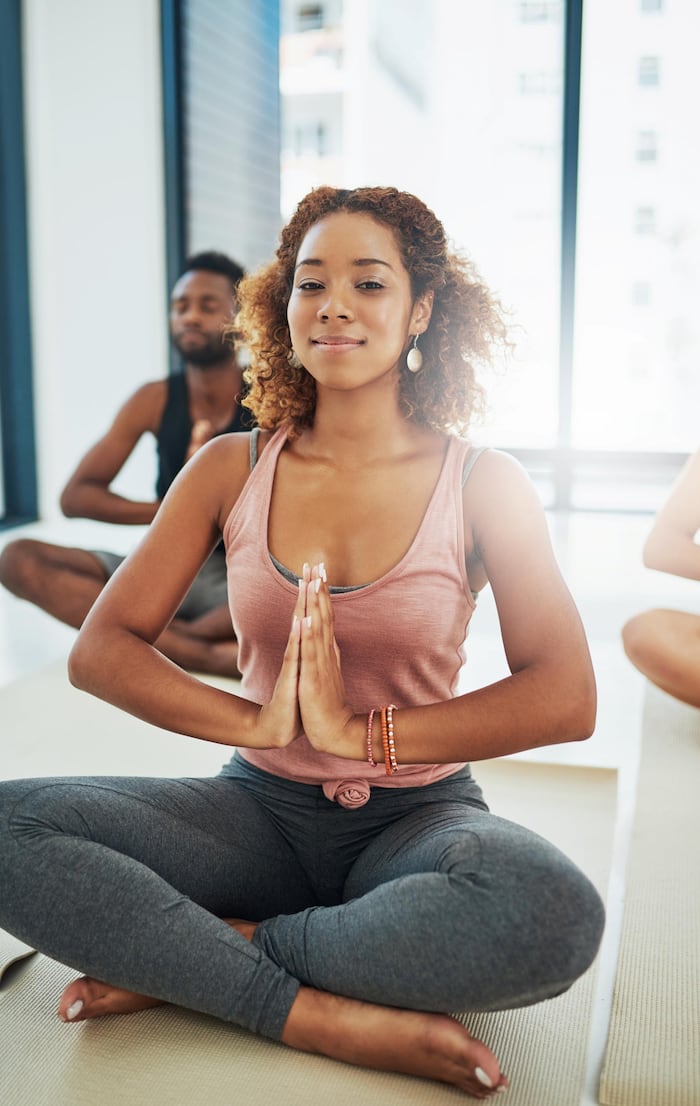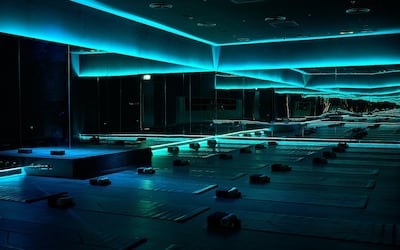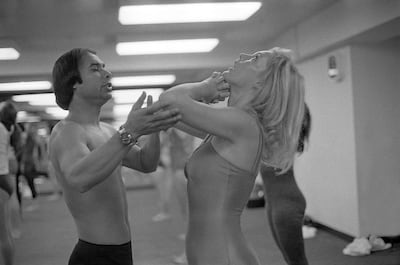
Simona Stanton was sure of one thing when she opened her yoga studio in Dubai’s Alserkal Avenue: no one who entered a class would hit an overpowering wall of heat. The Prague-born athlete – skiing, tennis and golf are among her passions – first got into yoga three years ago while earning her degree in psychology, and went on to train with California yogi Erica Blitz.
There are two rooms in Stanton’s airy two-storey Shimis Yoga Centre: upstairs is the Greenhouse, which features a living plant wall where students can practise vinyasa, hatha and yin yoga. On the ground floor is the Box. The interior is dark, with strip lighting that glows through the seven chakra colours during class.

Warm yoga sessions at Shimis are conducted in a darkened room with strip lighting, with the temperature set at 32°C
And while students will leave sweating, it will be largely due to their workout rather than the temperature of the room.
The case for warm yoga
That’s because at Shimis, it’s called “warm” yoga, not hot. Infrared panels heat the room to a gentle 32°C, which is a big drop from the 42°C to 45°C associated with hot yoga classes. “For me, it was just too hot and overwhelming,” Stanton says. “I would have to go into child’s pose during my practice and rest for a while because my body couldn’t handle it.”
With the temperature lowered, Stanton says students can safely tackle more difficult poses that are off limits in hot yoga, such as inversions. “You can do all the poses,” she says. “At the same time, you get a full workout experience, you sweat and burn a lot of calories.”
The case for hot yoga
Dubai Marina’s Dryp Wellness Centre has a different philosophy on the state of the thermostat. “I love saunas and overall sweating,” says its owner, Natasha Rudatsenko, who also operates the wellness platform Health Nag. “Every time I expose myself to heat, my endorphins and serotonin are through the roof. It’s the best mood booster.”
Metabolism and digestion are the physical processes affected positively by the heat – as are emotional states, she says. “It’s the best habit for great moods,” she says.
Before Rudatsenko found hot yoga, she had hypothyroidism and polycystic ovary syndrome, and was on hormone therapy that threatened to last a lifetime. “Instead, I became very much into hot yoga and stopped my medicine completely three months later,” she says. “My body found a way to normalise my hormones itself, just by reducing my stress levels through active sweat, stimulation of sluggish organs and improved blood circulation.”
Pros and cons of heat exposure
While there are real benefits for the body and mind when exercising in heat, the practice must be approached with caution as human thermoregulation is being challenged, says Dr Nasr Al Jafari, head of DNA Health & Wellness Centre Dubai. “During moderate exercise, your core temperature rises and the additional heat must be moved from the core to the skin,” he says.
“If heat production continues to outpace the rate at which heat can dissipate, the autonomic control of the cardiovascular system – that helps the body to control temperature – becomes impaired.”
I thought I would not survive the heat, but it’s all about hydration and mental strength. Sweating it off, you almost feel coolIf approached properly by easing into the exercise, avoiding coffee and other diuretics before, and properly hydrating before and after, then short-term passive exposure to heat can have synergistic health benefits, says Al Jafari. That’s because the exposure to heat causes a mild hyperthermia, which prompts the body to adapt its hormonal, cardiovascular and immunological systems in order to return to normal, and protect itself from further stressors.
“This is through a phenomenon known as hormesis, a defence response following exposure to a mild stressor, which provides protection from subsequent exposures to more extreme stressors,” he says. The way the body and mind react to this is similar to what happens during moderate to vigorous exercise. The benefits range from improved “cardiovascular and mental health, to athletic endurance and immune function, and may even offer a means to forestall the effects of ageing”, Al Jafari says.
In addition to gradual exposure to warmer yoga temperatures to let the body acclimatise, Al Jafari recommends caution when rehydrating afterwards. “Rehydration should occur using fluids with electrolytes, in order to replenish not just the lost fluid volume but also the salts, as only replacing water could cause imbalances and fluid shifts, leading to complications.
Useful once you get used to it
Ryen Hammond, 28, a social media manager for a communications agency in Dubai, found out about the power of extreme heat the hard way when she started doing hot yoga during college back in the US. “I have actually thrown up after a class,” she says. “That was probably before I was more aware of self-care … drinking enough water before.”
Fast forward and Hammond is now able to do hot or Bikram yoga at Dryp four to five times a week. For her, the 42°C-plus room is an essential part of the workout. The yoga aspect has also proved a tonic for turbulent emotions. “I struggled with anxiety for years and I love this yoga, which often starts with a breathing exercise. I can use those techniques and take them outside the studio,” says Hammond, adding that the intensity of hot yoga also appeals to her husband.
“Sometimes half the class is men,” she says. “I was really surprised. There are golfers, football players, men who’ve been practising for 10 years. It’s a real mix.”
Bijal Soni, 33, founder of influencer marketing agency Hala Social, was a HIIT lover when a former colleague introduced her to hot yoga. “I went for the first time and I was absolutely addicted,” she says. “I thought I would not survive the heat, but it’s all about hydration and mental strength. Sweating it off, you almost feel cool.”
The mental benefits of a hot room, too, are considerable, adds Soni. “This is the only workout when I’ve managed to switch off,” she says. “Because it’s so hot you need to focus.”
Hot yoga in the summer
The UAE’s extreme temperatures are not a factor for these warm or hot-yoga-loving yogis: their practice continues year-round. “There is not much difference between practising in hot summers or at wintertime,” says Rudatsenko. “You may need to be extra-hydrated and stock up on electrolytes. Potassium and magnesium are highly recommended for everyone spending summers in Dubai, as these are the first minerals we lose at light speed on hot days.” Newbies do need to make sure to hydrate properly and stop eating three hours before class starts, she adds.
Although the temperature may change from studio to studio, Stanton says there is one main benefit derived from any yoga practice: “Yoga classes teach you how to breathe properly. Once you are in control of your breath, I believe you’re in control of your life.”
The Bikram controversy

Controversial yogi Bikram Choudhury seen with actress Carol Lynley at his Beverly Hills studio in 1982. Joan Adlen / Getty Images
Despite having devotees around the world, a cloud has long hung over the term Bikram yoga, particularly after last year’s Netflix documentary Bikram: Yogi, Guru, Predator, which outlines alleged sexual abuse and predatory behaviour by founder Bikram Choudhury.
“It really made me sad, to be honest,” says Bijal Soni. “I was pretty much a brand ambassador for Bikram yoga. So I stopped calling it by the name and just call it hot yoga.” Fellow fan Hammond felt similarly uncomfortable but has kept doing Bikram, reasoning that, as the documentary alleges, Choudhury didn’t actually invent the 90-minute, 26-posture practice, instead taking it from another yogi.
”